What's So Gay About Yuri!!! on Ice?
by Jacob Chapman,Even if you haven't seen this anime season's breakout hit Yuri!!! on Ice yet, it only takes a quick Google image search to make it clear that this show is pretty fabulous.
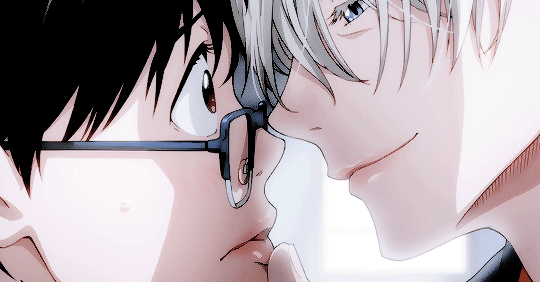
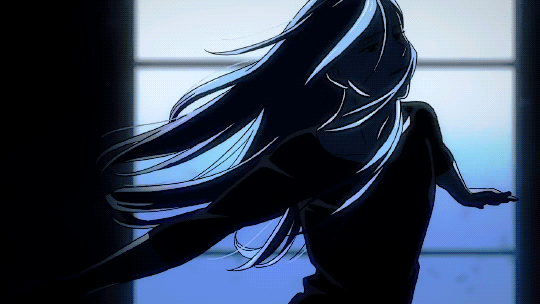

Just five episodes into its run, Yuri!!! on Ice has caught fire as a standout production that just so happens to be irrepressibly gay in subject matter, bolstered by the enthusiasm of squealing fangirls and LGBT otaku alike. (And thanks to its excellent animation and endearing story, plenty of straight dudes are getting into it as well!) At the same time, longtime anime fans might also be confused by the fervor surrounding this show's "gayness" in particular. After all, queer subject matter is pretty common in anime to begin with, right? Yaoi fangirls started threatening unsuspecting bottoms with giant paddles many years ago, and you usually can't scroll five posts in any given anime forum without reaching an avatar of two girls making bedroom eyes at each other. What's the big deal? What makes Yuri!!! on Ice any different from the heaps of anime packed with various flavors of homoeroticism that we get with every new season anyway?
There's a very simple answer to this question, but it might not answer much all by itself. Yuri!!! on Ice stars two complex characters of the same gender who harbor a directly sexual and romantic attraction to each other, in a relatable story that does not fetishize or exoticize these feelings. That might not sound all that complicated or unique by itself, and I definitely have to add the Big "But" that this answer is based entirely on visual cues rather than any direct text as of the show's first quarter. (As in, the characters have not literally turned to the camera and said "I'm gay" or "I love you" to each other yet, although variations on "I want you" have definitely popped up.) Still, that bolded sentence alone sets Yuri!!! on Ice apart from the vast majority of anime, even ones that might have queer themes or openly gay characters.
To find out how, we'll have to take a journey over the rainbow through the various ways that queerness usually shows up in anime, and how even some of the "gayest"-looking shows fall short when it comes to actually representing characters of different sexualities.
The biggest difference that cleaves the mass of seemingly homoerotic anime in two is the divide between text and subtext. There's a lot more of the latter because...
Anime is a wild, pulpy, nerdy medium full of explosive genre stuff for teenagers, and most explosive genre stuff for teenagers sells itself on violence and sex. While it's hardly the universal reason and maybe not even the biggest one, many people are attracted to anime for its surface adult elements, which is to say many people are attracted to anime in a very sexual way. Plenty of anime market themselves heavily toward one gender, but most titles shoot for a mixed demographic, which means fanservice of all stripes gets blended together in a big pot to attract a wide variety of tastes. Needless to say, sometimes what comes out the other side can look pretty gay on the surface.

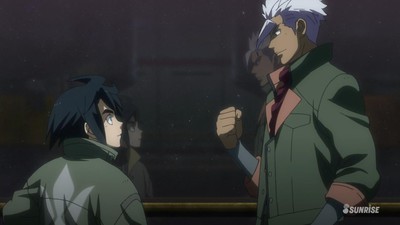
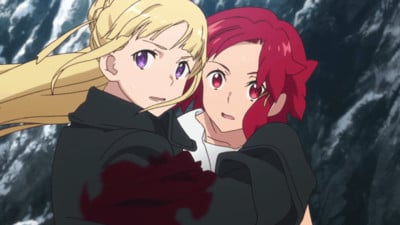

The four shows pictured above (Haikyu!!, Gundam: Iron-Blooded Orphans, Izetta: The Last Witch, and Flip Flappers) are all major titles from this season alone, and the screencaps make it clear that there's some major homoeroticism going on in all of them. However, this homoeroticism mostly comes from the viewer rather than the show itself, which is why a straight male viewer is probably more likely to watch Gundam: IBO without thinking that shirtless Mika standing next to shirtless Orga means they should start making out, while a straight female viewer might have started thinking this before they even took their shirts off. If you sexualize one gender more than the other, seeing more than one sumptuous specimen of that gender onscreen at a time is more likely to make you think about sex, possibly between the targets of your attraction themselves.
Still, no matter how much fanart gets drawn of Mika stroking Orga's abs, or Izetta taking a nap on Princess Fine's lap, the characters in the story are probably not going to ever express actual gay desire for one another, even if the show has a few episodes where they both get undressed in the same room. Given how horny teenage nerds can be, it doesn't take much to get the ball rolling. That classic moment of Naruto locking lips with Sasuke in the first episode of the series is obviously intended to be a goofy gag, and both characters are clearly destined to end up with girls from the get-go, but that could never have stopped fangirls from launching a fleet of NaruxSasu ships that have sailed the seas for well over a decade. Of course, gay subtext can also be intended by creators (more on that later), but pop culture is conversation, and most homoerotic subtext in anime is the kind that thirsty viewers create themselves.

For the most part, these subtext-friendly scenes happen not because the production staff is looking to inject a little gayness into their story, but because they know the viewer is interested in seeing these characters naked, maybe even naked together for double the monocle-pops and nosebleeds. It's meant to sell characters to the viewer, not to pair them up with each other in a story where this angle will probably never be addressed. Simply put, if the homoerotic imagery might be a coincidence that comes from putting sexy people of the same gender in the frame together, it's probably just subtext.
However, on the subject of Izetta: The Last Witch, it does seem pretty hard to believe that all those lovey-dovey expressions its heroines trade could be any kind of "accident." So what if creators are aware of the viewer appeal that the homoerotic imagery they're creating could have, but they still don't intend to have any overt gayness in the story? Well, this is commonly called "queer-baiting."
"Queer-baiting" can be a pretty harsh-sounding term, so I should clarify that there's no shame in enjoying or creating stories or characters that could be construed as "baity." The only real problem arises when people mistake "baiting" for actual gay representation, particularly if they are not LGBT themselves. It's a problem purely because "baiting" is the purposeful fetishization of same-sex attraction between ostensibly straight characters. That makes it a fetish tailored mostly for straight audiences, just like that "everywhere subtext" mentioned above. The characters remain straight in-universe so the assumed straight audience can feel more free to fantasize about them. Of course, without direct confirmation from the creative team of any given show, you can't really be sure what's deliberate baiting and what's just your own horny eyes playing tricks on you. Izetta is a perfect example. Is the show deliberately trying to make you think they have feelings for each other, or are they just really good friends who happen to look really sexy sitting on top of a rifle together? So when it came to picking an example of "baiting," I chose two shows where the homoeroticism is definitely deliberate.
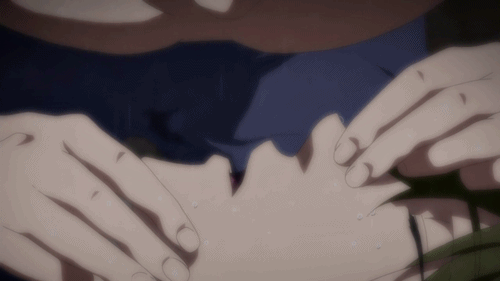

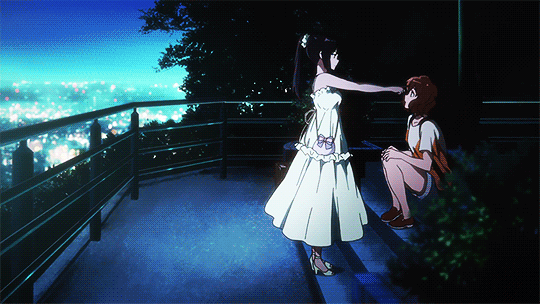
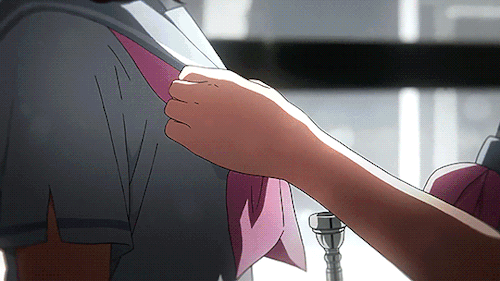
The boys of the Iwatobi Swim Club in Free! are practically asexual beings who don't express romantic interest in anything male or female at any point, and the girls of Kitauji High's concert band in Sound! Euphonium technically have male love interests that they just happen to either spend no time around or pine for at a distance. So it's curious that both shows are dripping with such overtly sexual imagery, and where else does all this sensual attention have to go but straight for their club-mates! Everything about the extremely voyeuristic (audience as secret observer) framing of each intimate moment between these guys and gals suggests that the hands behind the camera know exactly what all this looks like. Because the focus remains more on how the subjects look in these sultry shots rather than how they feel (in the interest of avoiding explicit confirmation or denial), it serves as bait to lure in hungry viewers, either straight in fervent pursuit of the fetishism or gay in desperate pursuit of something they can relate to. The odds that all this tongue-in-cheek romanticism will ever turn into an explicit statement of same-sex attraction are very slim, but it's not impossible, as evidenced by a rare example of deliberate baiting eventually morphing into explicit text in Madoka Magica.

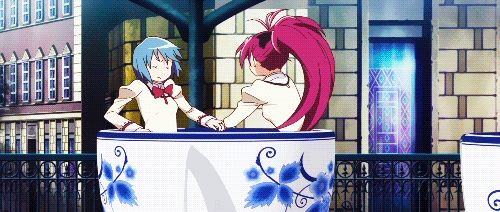
In the original TV series, the relationships between Homura & Madoka and Sayaka & Kyoko were entirely subtextual. If you tilted your head and squinted, you could definitely see some romantic yearning between these girls, but it was all just vague and tragic enough to come across more as a baiting hook for marketing the show to an otaku audience. (After all, the show was principally aimed at straight men.) After the TV series was a massive success (with both genders), it was relaunched as a series of movies culminating in a new addition to the story—where Sayaka and Kyoko were explicitly dating, and Homura's love for Madoka became more undeniably possessive and physical than it had been before. So don't think of "baiting" as a sin! Think of it as a halfway-house to potential gay representation in an anime, if audiences can prove that's what they actually want to see.
So what does actual text look like? With all this potential gay representation swept under the rug so far, are we finally at the level Yuri!!! on Ice is currently striving to achieve?
Nope, not yet.
Let's go back to the original sentence of what Yuri!!! on Ice achieves in terms of gay themes. Complex characters of the same gender who harbor a directly sexual and romantic attraction to each other, in a relatable story that does not fetishize or exoticize these feelings. All the examples from the subtext and baiting portions couldn't fulfill any part of that sentence past maybe the first two words (complex characters), depending on the show. Now that we've finally gotten past subtext and into text, we finally have one part of that sentence—"characters who harbor a directly sexual/romantic attraction to the same gender"—but we might lose the first word in the process! These characters are not complex largely because they're made to be laughed at or even feared for their queerness.

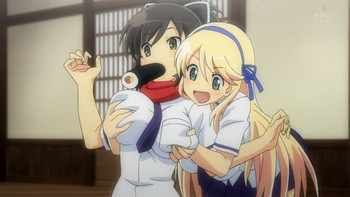
Yes, many canonically gay and lesbian characters in anime fall into hoary old stereotypes like the pedophilic queen gay guy or psychotic predator lesbian. If you've seen enough anime, you can probably rattle examples off like the back of your hand, so I hardly feel pressed to list them myself. It's the part of this list that needs the least explanation because, sadly, most of these damaging stereotypes appear in the most mainstream titles aimed at families in Japan, or the most bombastic and lascivious titles that appeal to the "weird Japan" curiosity of casual Western fans. Sidestepping these unfortunate stereotypes in pursuit of more complex queer characters can be rewarding, but that still leaves one clause dangling off the back of that sentence: "in a relatable story that does not fetishize or exoticize their feelings." As it turns out, that clause is pretty important, because it's very hard to find anime that includes it.
But wait, if you already have complex, sympathetic, explicitly gay characters, how can they not be in a relatable story that doesn't exoticize feelings of same-sex attraction? Well...
Okay, so we have a story with layered gay characters expressing their feelings and maybe even getting intimate with one another. There's only two questions left to ask.
Can real-life LGBT viewers see themselves in the story? If not, then who is it really made for?
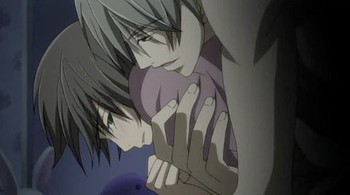

There's an old canard about lesbians being more likely to consume gay male porn than lesbian porn, because so much lesbian porn is made for straight men, and lesbian viewers can't connect to the way the performers express attraction for (or even give pleasure to) one another. In the anime sphere, the same tends to hold true for gay men and yaoi, but this branches out into many different examples of gay stories aimed almost exclusively at a straight audience.
In anime like Junjou Romantica, Sekai Ichi Hatsukoi, or Super Lovers, the gay men involved are usually codified into male or female typings, with actions dictated by exaggerated traits of domination or submission that hinder their characterization in favor of fetishizing the role female viewers most identify with or desire. They may also express a lack of understanding for their own attraction that's usually couched in terms like "I'm not gay, I'm only attracted to you" toward their partner. This adds an element of romance and exclusivity for the female viewer, but it usually isn't relatable to gay men watching. Even if the characters are made more complex with tragic backstories or nuanced emotional expression, they remain untouchable fantasy ideals that rarely express desire or affection in ways gay men see as familiar or confront issues (positive or negative) that they might face themselves.
Likewise, in anime like Sakura Trick, Fate/kaleid Prisma Ilya, or Yuru Yuri, the lesbian characters in the spotlight seem to have an infantilized understanding of their attraction to other girls that they express in either too-bashful or almost violently sexual ways that are likely to make lesbian viewers uncomfortable or just baffled. Just as in lesbian pornography aimed at straight men, the gay girls in these types of shows often express affection or intimacy in ways that suggest they know there's a camera on their bodies, overperforming either their innocence or lust in ways reminiscent of the virgin/whore complex that has long driven a lot of fetish material for straight men. In either case, it's difficult for queer women to connect with. (Of course, this is ignoring that most yuri is actually aimed at women both queer and straight, but explaining the ups and down of this "Class S" yuri as representation is its own can of worms that other people have written much more extensively researched essays on. The three examples listed above are not Class S anyway, but rather aimed directly at men.)
Obviously, this is a touchy subject, and every anime fan has their secret garden of fetishes they'd rather not be criticized. (Yaoi and yuri aimed at the opposite sex is definitely one of the most common, which is why anime like the examples listed above can justify their cost of production at all!) Just like with "baiting," there's no exact science to sussing out whether a gay romance anime is intended to be viewed as an otherworldly erotic fantasy for straight viewers, use its sensationalism to tell a more complex story, or something in between as the narrative evolves. LGBT viewers just have to decide for themselves what they find relatable and what they don't, while straight viewers have to decide how much fetishization they're comfortable with, either by compartmentalizing their enjoyment or embracing it.
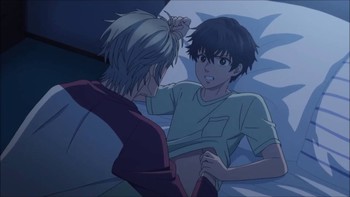
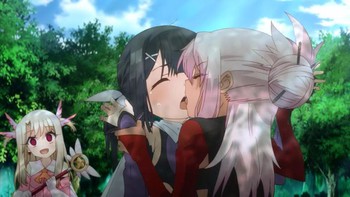
If you think of that "baiting" subtext mentioned before as a fork in the road that must move into text if it's pushed forward, you could see one side of the fork as becoming text for the purposes of telling a story that happens to feature gay characters, and the other side of the fork as becoming text for the purpose of sculpting a story around the "idea" of gay characters. The former branch usually leads to more complex characterization that LGBT viewers can relate to, and the latter branch usually leads to fetishization that straight viewers can romanticize more easily. It's not black and white by any means, but examining this intent "at the fork" is one way of trying to navigate the difference.
But in the end, it all comes down to the strength of the final product.

Whew! Hopefully all those thousands of words have made it easier to see just how hard anime has to work to get complex, sympathetic, relatable portrayals of queer sexuality that humanize us as LGBT people, stories that we can embrace without reservation in a flood of horny homoeroticism that makes up the anime market. (I'm gay and transgender myself, which means I never see people like myself represented in the media!) Still, just because it's difficult doesn't mean that anime creators don't dare to make it happen. For all the homoerotic baiting that may or may not become something more in this season's anime offerings, Magical Girl Raising Project just casually dropped a lovable, affectionate lesbian couple who live a happy life together into its fifth episode as major supporting cast members!
It's still early in Yuri!!! on Ice's run, so it could still stumble off the path to giving audiences a beautifully animated and well-told story of gay sexual awakening. However, given that director Sayo Yamamoto's previous creations featured prominent, respectfully portrayed LGBT characters (Atsuko in Michiko and Hatchin was a lesbian, Oscar in Lupin III: The Woman Called Fujiko Mine was gay and possibly transgender), there's plenty of reason to hope for the best!

In fact, if you're interested in checking out more anime with respectfully portrayed queer characters in major roles, there may be more options out there than you think! For gay male characters, there's No. 6, Gankutsuou: The Count of Monte Cristo, Showa Genroku Rakugo Shinjuu, Antique Bakery, and Doukyusei. For lesbian characters, there's Revolutionary Girl Utena, Aoi Hana, Yuri Kuma Arashi, Mikagura School Suite, and Simoun. There are even some anime that have both queer male and female characters in major roles, like Sailor Moon, Card Captor Sakura, and From the New World. (Transgender anime characters would be another column all by itself, and it's not a sexuality anyway. Transgender people can be any sexuality, just like cisgender people!) Feel free to share your own favorites in the forums!
discuss this in the forum (155 posts) |
this article has been modified since it was originally posted; see change history